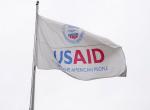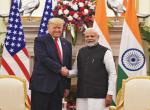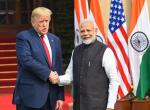The year 2022 brought a series of geopolitical changes of global magnitude that were last witnessed somewhat in the Cold War period. The economic slowdown and the disruption of the supply chains that were triggered by the COVID-19 pandemic got further intensified with the Russia-Ukraine conflict. The Russian military operations in Ukraine compelled the United States to take up the front seat in providing aid and assistance to the latter and uniting the European countries in doing the same. In the Indo-Pacific frontier, there was continuity in Chinese behaviour and actions which included military modernisation, deploying an increased number of warships in the Indian Ocean in the ‘garb’ of anti-piracy activities, and a disregard for other countries’ territorial sovereignty in the East China Sea, the South China Sea, the Taiwan Strait, and along the northern borders of India. The third term election of President Xi as the leader of the Communist Party of China reflected the extreme consolidation of power in the country. President Xi in the 20th CPC Congress emphasised more on external threats and also promoted Chinese security architecture for the region through its Global Security Initiative. Although the framework of Global Security Initiative (GSI) is yet to be adequately defined, it is clear that China is posturing itself to challenge the dominance of the US in the region.
All these co-occurrences impacted India, the US, and the Indo-Pacific region as a whole. As an assessment of the important events of 2022 that will have a continuing effect in 2023 and ahead, this article first provides a glimpse into the domestic trends and foreign policy challenges of the US. This is followed by highlighting some of the critical developments that took place in Indo-US relations. The article also touches upon some of the geostrategic happenstances in the Indo-Pacific region in 2022.
I. US: Internal Struggles and External Challenges
Domestic Issues and Midterm Elections
American politics witnessed a deepening ideological divide on a number of domestic as well as foreign policy issues in 2022. Domestically, issues such as the anti-abortion laws, Black lives matter, mass shootings, gun control debate, LGBTQ rights, climate change and immigration kept the country polarised. The US Supreme Court (which has a conservative majority presently) gave the verdict to overturn the Roe v. Wade ruling of 1973 which provided abortion rights to women. The Biden administration was able to pass the Respect for Marriage Act in December. The act gives statutory authority for same-sex and interracial marriages in all the States. The United States seemed to be struggling to strike a balance between leftist and conservative groups. This is also reflected in foreign policy decision-making.
Aid to Ukraine
In the foreign policy area, the Russia-Ukraine War brought back the great power rivalry into action. The European countries under the leadership of the United States have been providing monetary assistance and weapons to Ukraine to fight the Russian forces. However, there has been growing pressure on the Biden administration from the Republicans to cut the spending in Ukraine.
Face off with China
Even though Russia emerged overtly antagonist, the threat perception from China was the priority in strategic thinking in 2022. The challenge from China is one of the few issues that have bipartisan consensus in the US. The government documents such as the National Security Strategy Report (2022) indicated the PRC as a “pacing challenge” to the US and its allies and partners in the Indo-Pacific region. The document mentions the concept of “integrated deterrence” which includes elements including “integration across military (land, air, maritime, cyber, and space) and non-military (economic, technological, and information) domains” and integration with allies and partners of US through “interoperability and joint capability development, cooperative posture planning, and coordinated diplomatic and economic approaches.”[1] The military showdown near the Taiwan Strait by the PLA unravelled with the visit of Speaker Nancy Pelosi to the island country signifying one of the lowest points in US-China relations. The US is putting greater emphasis on its allies and partners in the region.
The trade war with China further got intensified in 2022. The US has hit the chip and semiconductor industry in China and has been urging its big Tech companies to diversify their sources. Even though moving out from China would be a challenging task given the cheap manufacturing costs and trade favourable environment but the decoupling process has been set in motion that is not expected to take the relations back to normal. The total monthly value of trade between the US and China in goods was USD 62.91 billion in December 2021 and after various fluctuations over the year amounted to USD 52.46 billion in November 2022.[2]
Midterm Elections: Implications
The midterm elections in the US that were held in November 2022 left the Congress divided as the Democrats were able to secure the Senate, however, the Republicans were able to get a majority in the House. A lame-duck congress is going to impact the decision-making of the Biden administration. Domestic legislation such as Biden’s Inflation Reduction Bill is expected to be blocked by the House Republicans. In the foreign policy domain, the Republicans might not be allowed to freeze aid below what has already been committed to Ukraine, but they would in turn not allow the Democrats to increase the amount further. The bipartisan trend of a hawkish approach towards China and deepening ties with India are likely to continue.
II. India-US Relations: A Rain-check in 2022
India and the United States set some higher benchmarks in their relationship in 2022. India was caught in the middle of the Russia-Ukraine conflict; a segment of policymakers in the US and the western media criticised India for procuring oil and weapons from Russia and not backing the sanctions against Russia in the UN. India, however, took a firm diplomatic stance in condemning the war and advocated for a path of diplomacy and dialogue that could end it. The conflict emerged as a litmus test of the deepening Indo-US ties over the years. However, India found itself in an exceptional and privileged position in the US strategic community. This was reflected through the statements made by the government representatives as well the various government reports.
Government officials from India and the US also engaged in various high-level visits and dialogues. PM Narendra Modi and President Joe Biden met thrice in person in 2022 – at the Quad Summit held in Tokyo in May, at the G7 Summit in Germany in June, and on the sidelines of the G20 Summit in Indonesia in November. The External Affairs Minister S. Jaishankar paid several visits to the US and had dialogues with Secretary Blinken. India-US also held the fourth 2+2 dialogues in Washington DC in April 2022.
NDAA 2022 and CATSAA Waiver
The challenge posed by China was the top foreign priority for the US. Citing the threat that India faces from China; the National Defense Authorization Act of 2022 under the stewardship of Indian-American Congressman Ro Khanna gave India a waiver from the CATSAA sanctions to procure S400 weapons from Russia. This was a landmark step in India-US relations as the CATSAA waiver has been a long-term issue. The waiver got bipartisan support for the legislative amendment of the National Defense Authorization Act which was approved by voice vote as part of an en bloc at the floor discussions. [3] Partnership with India is crucial for the US’ Free and Open-Indo-Pacific policy.
Bilateral Trade
India has a trade surplus with the United States. According to the US Census Bureau, for the year 2022, bilateral trade in goods stood at around USD 1,23,494.50 million which was slightly higher than the 2021 figure which was around USD 1,13,224.80 million. In a post-COVID scenario, there has been an upward trend in trade. Between 2018 and 2022, the trade in goods has increased approximately by 170% between India and the US.[4] However, the rising protectionist tendencies within the US did not allow room for negotiations on a Free-Trade Agreement with India. Trade in defence equipment and technology was one of the most critical aspects of bilateral trade.
Other Engagements
India and the US also engaged bilaterally in a number of areas such as cybersecurity cooperation, counter-narcotics, and counter-terrorism. The third Counter Narcotics Working Group (CNWG) meeting between the United States and India was held in July 2022 in New Delhi. For the purpose of collaborating on drug-related issues, an Amended Letter of Agreement (ALOA) was signed. In September 2022, the India-US Cyber Dialogue was held in Washington, D.C. India also took part in the Counter Ransomware Initiative [CRI] meeting, which was held in Washington D.C. on November 1, 2022.[5] On December 12-13, 2022, New Delhi hosted the 19th meeting of the India-US Counter Terrorism Joint Working Group and the 5th session of the India-US Designations Dialogue. [6]
Indians make up nearly 21% of all international students in the United States. Some relaxation was observed in the issuance of visas to Indian students. In 2022, approximately 82000 student visas were issued in India, the majority of which were for graduate programmes.[7] The Indo-US relations are on an upward trajectory and they will continue to be the same given the more real and evident threats from China.
III. Indo-Pacific in 2022: Key Developments
From a security perspective, the Indo-Pacific region witnessed similar trends with regard to the actions and ocused of China. In fact, more assertion was observed in terms of its military ocused zing and disregard for other countries’ territorial integrity in the South and East China seas and the northern borders of India.
The People’s Liberation Army’s military drills in the Taiwan Strait, enhanced Russia-China closeness and the increased risks of the use of nuclear weapons in the Korean Peninsula have worried Japan and South Korea. Given the close proximity of Okinawa Prefecture to the Taiwan Strait, the threat of an attack from the PLA seems to be more real than before to Japan. Tokyo is set to double its defence expenditure over the next 5 years to enhance its capabilities. There is a substantial hike in the defence budget for 2023 which amounts to a record 114.4 trillion yen.[8] Similarly, strategic thinkers in South Korea are not shying away from ocused zin China for not ocused zing the issue of North Korean aggression. President Yoon Suk-yeol is taking a more firm stance on the possibility of developing nuclear capabilities. In November, he also announced South Korea’s Indo-Pacific Strategy which seeks diversification of economic relations and promotion of rule-based order in the Indo-Pacific region.[9] The closeness between Russia and China and Russia’s growing dependency on the latter is another matter of concern.
The growing presence of Chinese warships in the Indian Ocean is a common phenomenon. The entry of the dual-use vessel ‘Yuan Wang 5’ with the capabilities of spying in Sri Lanka’s Hambantota Port and the Chinese incursion in the Tawang area of Arunachal Pradesh have created worries in New Delhi.
From the economic perspective, the supply of essential goods especially food, fuel, and fertilizers disputed by Russia- Ukraine had severe repercussions in the Indo-Pacific region as well. Indonesia, the chair of G20 for the year 2022 made a great effort in building consensus for supply chain resilience and post-pandemic economic recovery. Quad summit and launch of the Indo- Pacific Economic Framework on the sidelines also ocused on economic recovery and a varied number of issues.
QUAD Summit and IPEF
The Quad Summit was hosted by Japan where President Biden, Prime Minister Anthony Albanese, Prime Minister Modi, and Prime Minister Kishida met in person. This time countries focussed on diversifying the areas of cooperation which included– the Indo-Pacific Partnership for Maritime Domain Awareness (IPMDA), Quad Fellowship, Quad Vaccine Partnership and Global Health Security, Climate, Critical and Emerging Technologies, Cybersecurity, Space, Infrastructure and Humanitarian Assistance and Disaster Relief.[10] However, the summit did not bring up any concrete security layout for establishing peace, stability and rule-based order in the Indo-Pacific region. Quad’s focus seemed to be focussed on non-security issues. However, the security aspect of the grouping is yet to unravel.
The Quad summit provided the platform for President Biden to launch the Indo- Pacific Economic Framework with 14 members including Australia, Brunei, India, Indonesia, Japan, the Republic of Korea, Malaysia, New Zealand, the Philippines, Singapore, Thailand, and Vietnam from the region. IPEF focuses on four pillars of cooperation: Trade; Supply Chains; Clean Energy, Decarbonization, and Infrastructure; and Tax and Anti-Corruption. India, however, has agreed to partner only on three of the pillars. The trade aspect of IPEF has not been considered favourable for Indian businesses by the Indian government. Hence, India has stood out of it.[11] More negotiations are expected to take place in this aspect.
Conclusion: Moving Ahead
The new and deepening existing challenges made the countries strengthen strategic ties with each other. This trend is going to continue. Quad posture on security is yet to unfold. Given the geostrategic and geo-economic importance of the region, greater involvement of the European Union, France, Germany and the UK is expected who are already focusing on securing their stakes in the Indo-Pacific. Enhanced bilateral agreements such as the Japan-UK defence cooperation and mini-lateral arrangements such as the AUKUS. Maritime cooperation is becoming a top priority for various stakeholders in the region. Joint defence exercises such as Malabar exercises are expected to be more intensified in the coming times.
ASEAN has been making efforts to bring major powers to dialogue on platforms such as the East Asia Summit and Asia-Pacific Economic Cooperation. It has been striving to come out with a binding Code of Conduct vis-a-vis Chinese encroachment in the South China Sea. However, the attempt is facing a lot of challenges and seems far from getting concretised in the near future.[12] The “integrated deterrence” with increased engagements with its allies and partners in the Indo-Pacific region is supposed to be the centerpiece of the US foreign policy. India has shown a unique diplomatic leadership in its stance on the Ukraine conflict and bringing up the cause of emerging economies and the Global South in various global platforms. A lot is being expected from India’s G20 presidency in promoting a mechanism to establish a rule-based order in the Indo- Pacific region and creating a more conducive environment for dialogues and diplomacy in a divided world.
Endnotes :
[1]The US White House, National Security Strategy, October 2022, URL: https://www.whitehouse.gov/wp-content/uploads/2022/10/Biden-Harris-Administrations-National-Security-Strategy-10.2022.pdf Accessed on January 2, 2023
[2]Yihan Ma, “Total monthly value of U.S. trade in goods (export and import) with China from November 2020 to November 2022”, Statista, January 10, 2023, URL: https://www.statista.com/statistics/277494/total-value-of-us-trade-in-goods-with-china/#:~:text=In%20October%202022%2C%20the%20total,billion%20U.S.%20dollar%20import%20value. Accessed on January 12, 2023
[3]Press Trust of India, “̌U.S. House votes for India-specific CAATSA waiver”, The Hindu, July 15, 2022, URL: https://www.thehindu.com/news/national/us-house-votes-for-india-specific-caatsa-waiver/article65642679.ece (Accessed on January 12, 2023)
[4]US Census Bureau, “Trade in Goods with India”, URL: https://www.census.gov/foreign-trade/balance/c5330.html (Accessed on January 12, 2023)
[5]Indian Embassy USA, “India-US Bilateral Relations – A Brief”, November 2022, URL: https://www.indianembassyusa.gov.in/pdf/menu/Wasington_IndUs_21Nov2022.pdf (Accessed on January 12, 2023)
[6]US Embassy India, “Joint Press Statement of the 19th meeting of the India-USA Counter Terrorism Joint Working Group”, December 13, 2022, URL: https://in.usembassy.gov/joint-press-statement-of-the-19th-meeting-of-the-india-usa-counter-terrorism/ (Accessed on January 10, 2023)
[7]n5
[8]FP staff, “Japan unveils record 114.4 trillion-yen budget in fresh boost to military capacity”, FirstPost, December 23, 2022, URL: https://www.firstpost.com/business/japan-unveils-record-114-4-trillion-yen-budget-in-fresh-boost-to-military-capacity-11861681.html (Accessed on December 26, 2022)
[9]Jo He-rim, “South Korea aligns Indo-Pacific strategy with US, Japan: experts”, The Korea Herald, URL: https://www.koreaherald.com/view.php?ud=20221114000604 (Accessed on December 26, 2022)
[10]The US White House, “FACT SHEET: Quad Leaders’ Tokyo Summit 2022”, May 23, 2022, URL: https://www.whitehouse.gov/briefing-room/statements-releases/2022/05/23/fact-sheet-quad-leaders-tokyo-summit-2022/ (Accessed on December 29, 2022)
[11] Indian Ministry of Commerce and Indutry, “Indo-Pacific Economic Framework (IPEF) for Prosperity ministerial meet was inclusive and fruitful: Shri Piyush Goyal”, Press Information Bureau, September 10, 2022, URL: https://pib.gov.in/PressReleasePage.aspx?PRID=1858243 (Accessed on December 29, 2022)
[12]Arjun Sengupta, “With Rajnath Singh’s comments at ASEAN meeting, a look at the attempts for a ‘Code of Conduct’ in the South China Sea”, The Indian Express, November 26, 2022, https://indianexpress.com/article/explained/explained-global/south-china-sea-code-of-conduct-rajnath-singh-8289190/ (Accessed on December 27, 2022)
(The paper is the author’s individual scholastic articulation. The author certifies that the article/paper is original in content, unpublished and it has not been submitted for publication/web upload elsewhere, and that the facts and figures quoted are duly referenced, as needed, and are believed to be correct). (The paper does not necessarily represent the organisational stance... More >>
Image Source: https://th-i.thgim.com/public/incoming/ihw0id/article65453477.ece/alternates/FREE_1200/AFP_32AU36H.jpg











Post new comment